Exporting G Suite mailboxes to PST can be challenging since both entities are associated with different environments. Here, you will learn different ways to securely export G Suite emails to Outlook PST file. Additionally, we will try a professional tool, Kernel Google Workspace Backup and Restore, to achieve a quick email export process.
Google Workspace is a sophisticated platform that accumulates different tools for user productivity and team collaboration. Apps like Gmail, Calendar, Meet, Chat, Drive, Sheets, Keep, and many more are all part of Google Workspace, allowing users to accomplish various personal and professional tasks. Recently, Google also integrated their AI assistant Gemini into the workspace to assist users in tasks such as composing new emails, making documents, helping in performing repetitive tasks and a lot more.
However, often, you need to export Google Workspace emails to PST file due to reasons like email client switches, requirement of a specific feature, etc. Also, many users prefer to export G Suite emails to Outlook PST file to create a backup. Experts recommend maintaining consistent backups of emails to secure data especially after the recent rise in cybercrimes and virus attacks.
Extracting data from G Suite and saving it to PST is not hard; you just need the right approach. In 2025-2026, there are 2 reliable ways to export multiple G Suite mailboxes. In the upcoming section of the blog, we will discuss how you can export G Suite mailboxes to PST with manual methods and an automated solution designed for the same. Before that, let’s discuss why users need to export Google Workspace emails.
Why export G Suite emails to PST?
Several reasons could influence the user to export Google Workspace mailbox to Outlook PST format. Top factors to export emails to PST file are given below:
- Users need to switch email clients from Gmail to Outlook. Therefore, they want to extract the data in PST format.
- PST files enable users to access email offline.
- You can enable password protection in PST files, which adds another protection layer to the data involved.
- It is an excellent option to keep a backup of all your precious data.
- PST files offer several additional benefits, such as their wider accessibility, portability, etc. These are helpful in mailbox management.
Top Methods to Export G Suite Emails to PST
To export Google Workspace emails to PST, you can use two native methods. Both require technical expertise and G Suite admin credentials. However, depending upon the data size, it could take days to safely export your data with the techniques below. In case you urgently need to transfer emails from Gmail to Outlook we will discuss an advanced tool later in the blog.
Method 1: Using G Suite/Google Workspace Admin console
Using the G Suite Admin console is one of the best methods to export G Suite mailboxes to PST. From here, you can use the Data Export tool to export your mailboxes. Before using this utility, you need to make sure of the following things:
- Have an account in your domain for more than 30 days.
- Credentials and permissions of Super administrator for your domain.
- Activation of 2-step verification on your account.
- Have less than 1,000 users on your Google Workspace account.
Only after confirming these requirements you can move on to use the Data Export tool with the following steps:
Step 1: Open the Data Export tool in the G Suite admin console by clicking Open at the top-right; click Data Export under the Tools.
Step 2: Now, click Start Export.
The tool might take up to 9 days to export your data based on the size of the mailboxes. After exporting the data, you can even check the export report to see the data. Once the data is exported successfully, you will get an email with the information to export it to an alternative service.
- You cannot export specific data with the Data Export Tool
- You have to wait for 30 days to repeat data export after the last export.
- It does not support exporting data of all types
- The time can vary according to the size of the data
- The data will be stored in zip format in the Google Cloud
Method 2: Using MS Outlook
Most of you might already know that you can export Outlook data to PST using the import/export feature. You might not know that if you configure your G Suite account with Outlook, it is easier to export that data to PST.
However, before doing so, you will have to keep in mind the following pre-requirements:
- You need to configure the G Suite account with Admin credentials
- You will have to backup G Suite mailboxes one-by-one
- Make sure your G Suite doesn’t contain more than 100 mailboxes
To add your Gmail IMAP account in Outlook you will need to perform the following steps:
- Enable IMAP under Forwarding and POP/IMAP in Gmail settings.
- Turn on access to less secure app in Gmail.
- Open Outlook click File > + Add account.
- Enter your Gmail account credentials and follow the process.
Performing the steps above will configure your G Suite account with Outlook securely.
After you are done configuring the Gmail account in Outlook. We need to export the Gmail data to PST using the process shared below:
- In Outlook, click File > Open & Export > Import/Export.
- Choose Export to a file, then select Outlook Data File (.pst).
- Select the data to export and click Next.
- Provide a location to save PST file and click OK.
Following the 2 parts discussed above, you can successfully export Gmail data to PST.
Export Google Workspace emails with MS Outlook: Limitations
No doubt exporting Gmail data with Outlook is a faster process than utilizing the Google Data Export tool. Still, this approach also has its limitations, that are given below:
- Gmail & Outlook use their own way to store and structure data. Configuring a Gmail account in MS Outlook might not be able to perform a 100% data replication.
- To add a Gmail account to Outlook you will need to enable Less secure app access option in Gmail settings. This is a potential security threat.
- Cannot save specific email or data item with the manual methods.
- It can export data from a single account only, and only two saving options are available – PST and CSV.
- PST file is accessible in Outlook only.
- Sometimes, the cells in CSV files are empty due to improper arrangement of data.
- It can export the data from an active account only.
- Outlook has a size limit of 50GB for PST files. If the mailbox items total size exceeds this limit, then some Gmail data will be skipped during the saving process.
GYB command line tool for G Suite backup
Perform the backup of your Gmail data using the Get Your Back (GYB) command line tool that allows to save your G Suite backup to local drive.
Technically sound users can simply utilize this command line tool while following basic procedure. It works by using Gmail API to connect with your Gmail account to access emails. It saves the local copy of your Gmail data in Tar.xz file format, that you can extract to access saved files.
To know more about the complete G Suite backup process using GYB, you can explore Github.com help guide for GYB backup.
The free facility GYB command line tool offers are great for users to backup Gmail data, but it inherits few restrictions.
- The output file is not .pst, but a .zip file.
- It only backup emails from your Gmail account.
- You cannot backup other G Suite files like documents using GYB.
- The process may take longer time to complete.
- You can experience issues to backup Gmail messages with more than 10 mb size.
Export G suite emails to PST using an automated tool
If you don’t want to trouble yourself with any hassle that comes with manually exporting the Google Workspace mailboxes, there is a straightforward solution; Kernel Google Workspace Backup and Restore. It is an extensive utility that is developed to help users export G Suite mailboxes to PST.
The software comes with several advanced features, which make it a reliable option for users. Some of its major functionalities are:
- Export multiple G Suite mailboxes at once.
- No need to wait for hours to save data, as in the case of manual methods.
- The tools maintain complete data integrity and structure.
- Ability to save specific data from mailbox.
- Optimized algorithms for a quick G Suite to PST process.
- Smart filters to save mailbox items according to user’s customization.
- Auto-split output file to generate compact mailboxes and prevent corruption.
- Allows users to save Google Drive data locally, along with emails.
Quick Steps to Export Google Workspace Emails to PST
With this backup tool, you can export single as well as multiple mailboxes at once. Here, we will discuss step-by-step guide to export Google Workspace mailboxes.
Step 1: Install the Kernel G Suite Backup tool and open it. Select the Mailbox, Groups, and Drive Backup option. Then, click Add to add the G Suite account.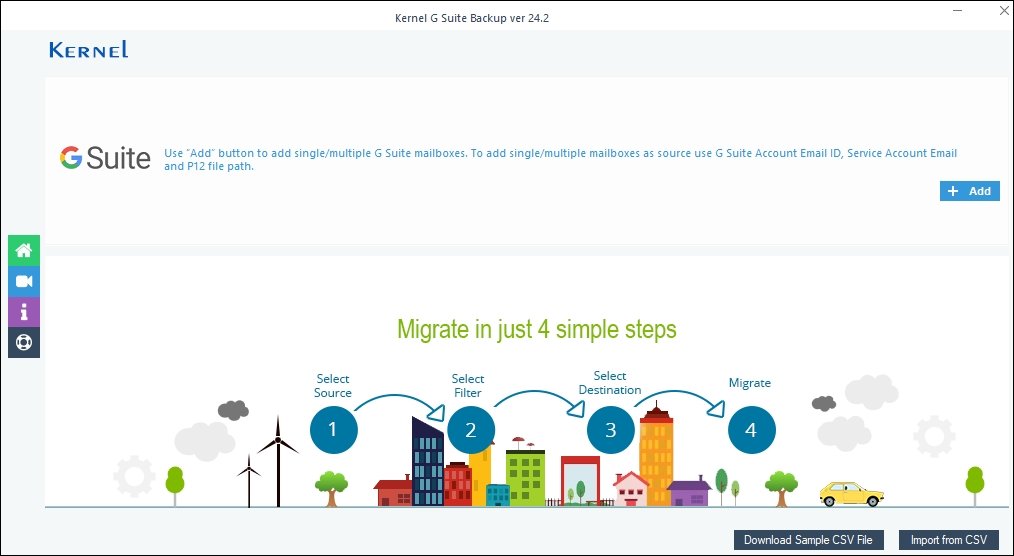
Step 2: Provide the G Suite login details like email ID, service account ID, and P 12 file path. Select the option ‘List all mailboxes with above credentials,’ and then click Get User Mailboxes.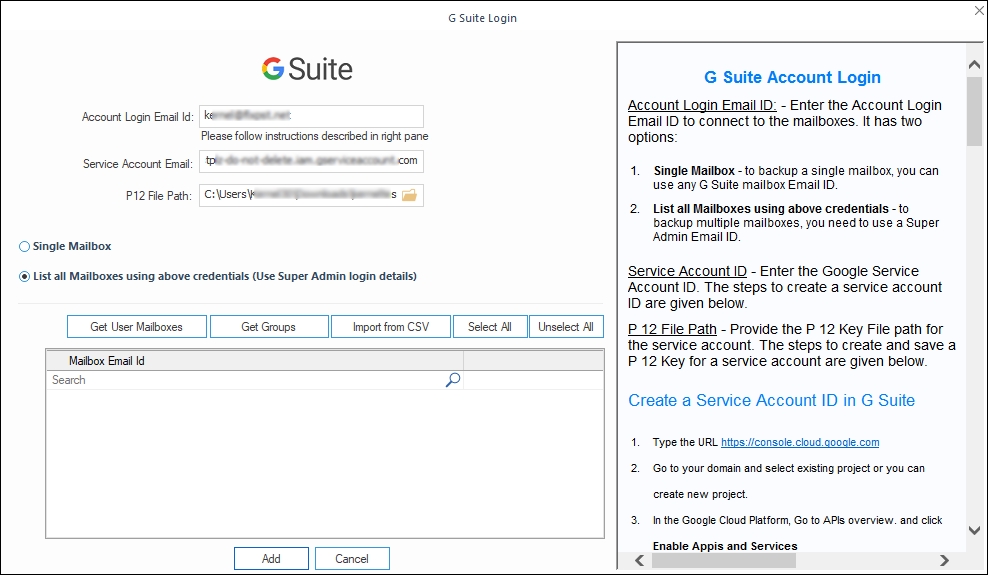
Step 3: The tool will display all the mailboxes. Select the required mailbox and click Add.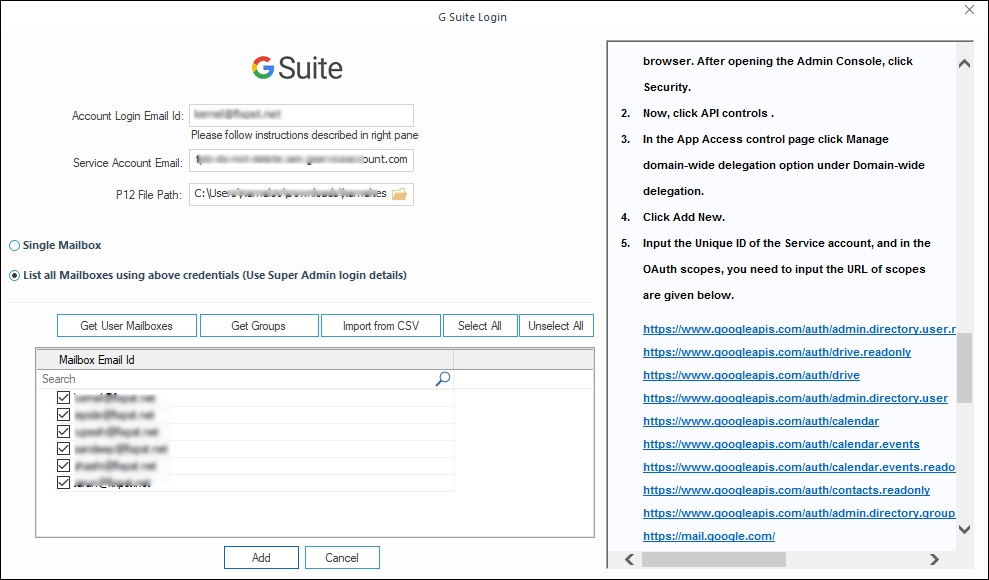
Step 4: Once the selected mailboxes are added, click Set Filter and Migrate.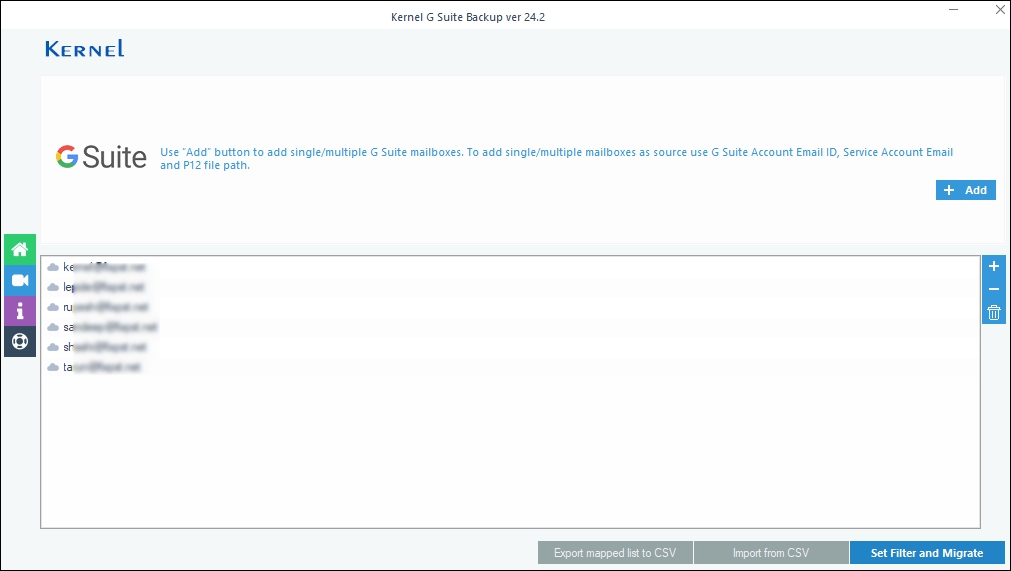
Step 5: In the filter section, apply specific filters to the G Suite mailboxes and click I am OK, Start Migration.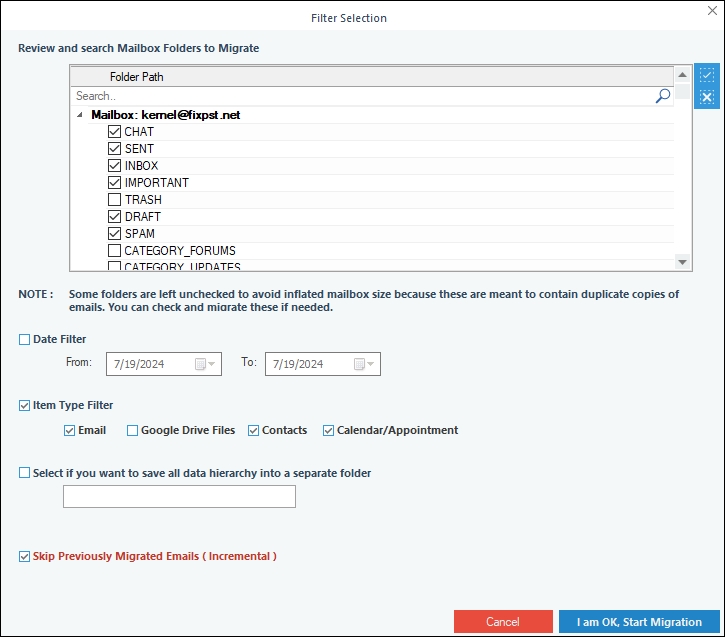
Step 6: Select the specified format as PST to save the G Suite mailboxes.
Note: To create multiple PST files, select the option Split Outlook PST File After and specify a size for the same.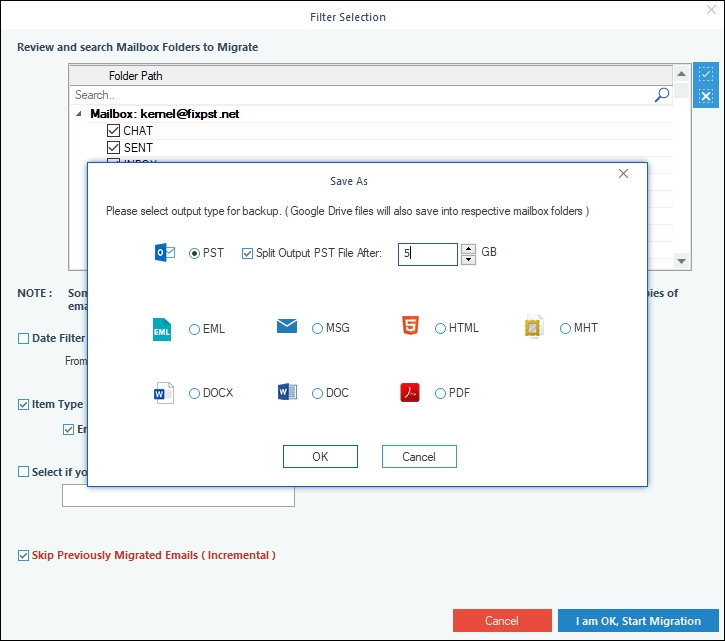
Step 7: Choose a location to save the backup PST file on your system.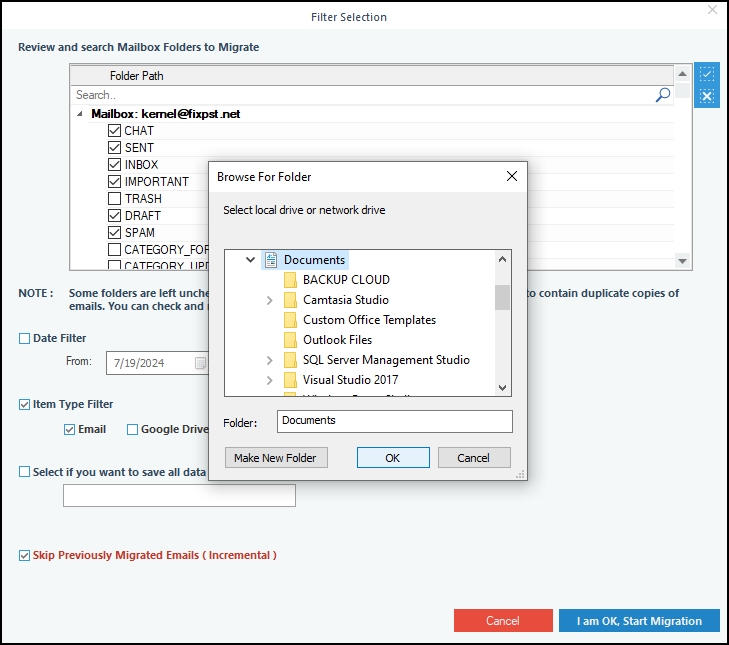
Step 8: The tool will start to export Google Workspace emails to PST.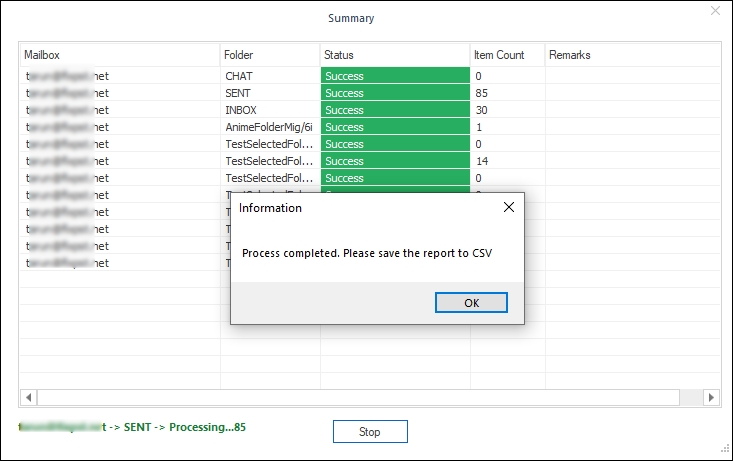
Once it is complete, a message will appear on the screen. Later, you can save the export report in CSV format.
Conclusion
Google Workspace and Outlook are reliable platforms, but email backup is not negotiable. Choose any method we discussed in the blog to easily export G Suite emails to PST. But the manual method could take days to safeguard your data. If you need to quickly backup multiple Google mailboxes, you must use the Kernel Google Workspace Backup and Restore software
It has incredible features that support unlimited backup from multiple mailboxes by providing simple login options and adaptive filters. Apart from PST format, you can save data in various other formats like MSG, PDF, EML, HTML, MHTML, etc.
FAQ's
Question: How many days will it take to download data from Google Admin Console?
Answer: There is no specific time frame; it depends on various factors like how many mailboxes you want to export, the total size of the selected mailboxes, etc. After creating the export job, you will automatically receive a download link in your inbox.
Question: When we export G Suite emails to PST, what components of emails are saved in the output file?
Answer: Every detail about the email is saved. Be it original message, attachments, metadata, contacts, calendars, or anything else.